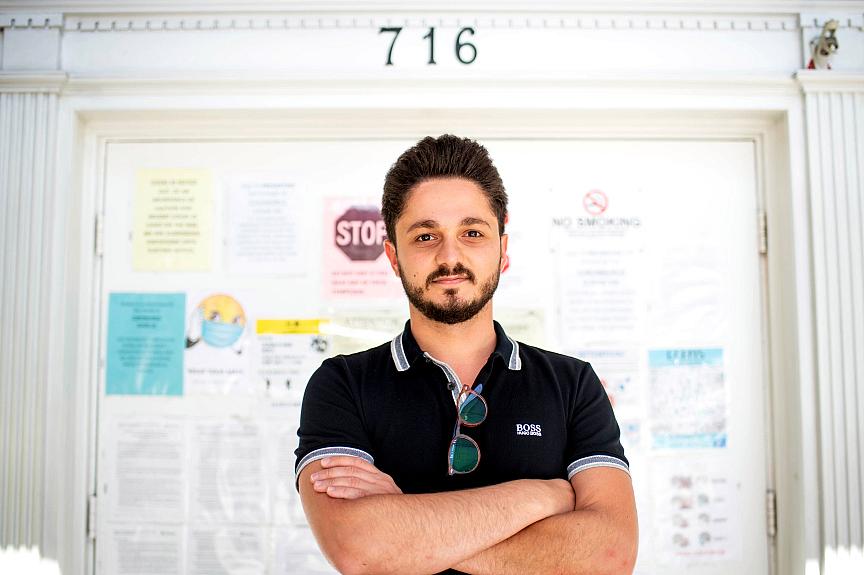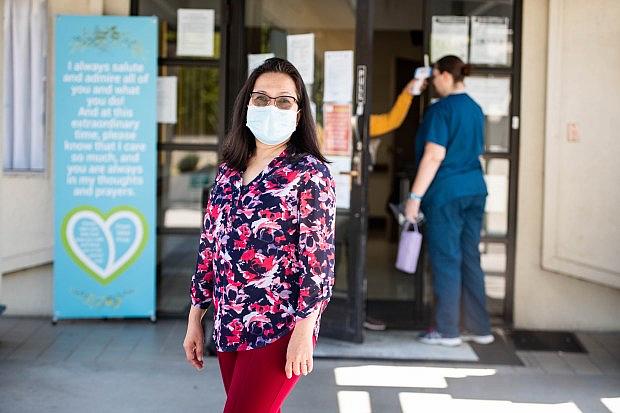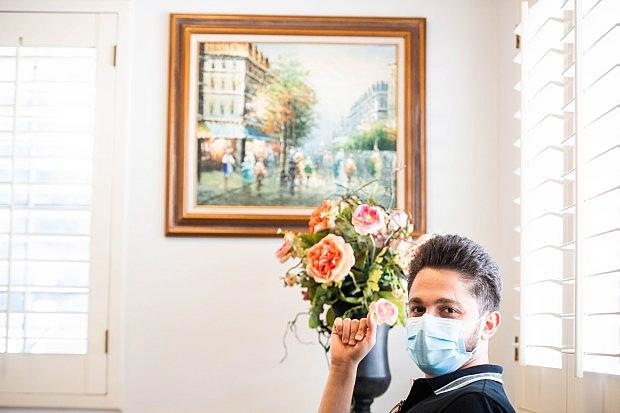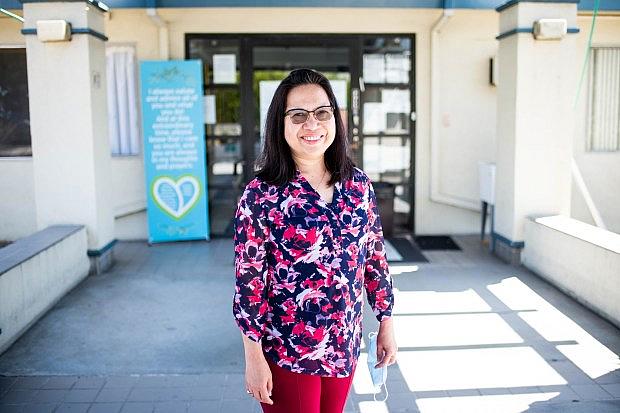A tale of two Southern California nursing homes in the era of coronavirus
This story was produced as part of a larger project by Brenda Gazzar, a participant in the 2020 California Fellowship.
Her other stories include:
'This isn't a drill': How LA's Motion Picture home battled coronavirus
‘Pandemic within a pandemic:’ What’s fueling LA County’s coronavirus death toll in nursing homes?
Known and loved: These six residents of LA’s Motion Picture home died of coronavirus
‘Behind the 8-ball:’ Many Southern California nursing homes hit hard by coronavirus had prior issues
Family of nursing home resident who died: ‘She had 3 really good years there and 1 really bad week’
Social isolation takes toll on Southern California nursing home residents during pandemic holidays
Can California nursing homes avoid the next ‘humanitarian crisis?’
This nursing home ‘angel’ struggled to support her family. Then she got coronavirus…

Hrag Bekerian, administrator of Gem Transitional Care Center, poses at the Pasadena center on Friday, August 7, 2020. The nursing home had a high number of patients and staff including Bekerian who contracted COVID-19. Today they have no coronavirus patients
(Photo by Sarah Reingewirtz, Los Angeles Daily News/SCNG)
Administrator Hrag Bekerian felt confident, he said, that they were taking the right precautions at Gem Transitional Care Center before the coronavirus struck.
The four-star-rated nursing home on South Fair Oaks Avenue in Pasadena had closed its doors to visitors a week before the state’s guidance. Managers held frequent training sessions, screened all entrants and ramped up hand-washing checks.
“We believe we were well-prepared,” said Bekerian, 31.
Yet since mid-April, nearly 55 residents at Gem Transitional tested positive for COVID, more than a dozen of whom died. With typically around 65 daily residents, the nursing home has one of the highest COVID-related resident death rates in Los Angeles County for its population, according to a review by the Southern California News Group.
A caregiver gets a temperature check while Nelida Arlante, administrator of Camellia Gardens, poses at the Pasadena care center on Friday, August 7, 2020. Arlante says a dozen staff members and three residents tested positive for COVID-19, with one patient death. Arlante believes the strict rules, educational sessions and oversight she implemented at her facility helped curb the spread of the virus. (Photo by Sarah Reingewirtz, Los Angeles Daily News/SCNG)
About four miles up the road is Camellia Gardens Care Center. As a one-star facility, it has the lowest possible overall rating on Medicare’s Nursing Home Compare. The slightly larger home had three residents contract COVID and only one death, said Nelida Arlante, the home’s administrator.
Arlante believes their vigilance helped curb the virus there. As a former physician in the Philippines, Arlante said, she may have had an edge.
2,900 deaths in region
More than 2,900 nursing home residents have died of COVID-19-related causes in Los Angeles, Orange, Riverside and San Bernardino counties, comprising about one-third of this region’s total coronavirus deaths, according to data from the California Department of Public Health.
Nursing homes across the region have touted early studies showing that location and size largely determine how they’ve fared with the virus. But it’s becoming increasingly clear that several other factors can help seal a home’s fate.
Mass testing with quick results and adequate personal protective equipment are clearly important, experts say. Nursing staff levels, infection-control practices, resident demographics, leadership and even a home’s for-profit status also can contribute to the death toll.
“It’s all those factors,” said Charlene Harrington, professor emerita at UC San Francisco and a registered nurse.
Behind the high death toll
Bekerian believes the high death toll at his for-profit facility is due at least partly to the type of residents it serve
Hrag Bekerian, administrator of Gem Transitional Care Center, poses at the Pasadena center on Friday, August 7, 2020. The nursing home had a high number of patients and staff including Bekerian who contracted COVID-19. Today they have no coronavirus patients. (Photo by Sarah Reingewirtz, Los Angeles Daily News/SCNG)
People of color, who are disproportionately affected by the virus, also made up nearly 60% of their residents, according to data Bekerian provided.
California nursing homes with overall quality ratings of four and five stars were less likely to have COVID-19 cases and deaths when adjusting for a home’s size and patients’ race, according to a study in the Journal of the American Medical Directors Association. Nursing facilities with smaller white populations and for-profit ones were more likely to have higher cases and deaths.
Learning hard lessons
Like with many homes, there were also hard lessons they learned in real time.
First, Bekerian said, guidance from local, state and federal agencies kept changing.
He also realized it would have been best to quarantine staff working at multiple facilities at home for 14 days right away. Instead, Gem Transitional had at first waited for COVID-19 cases to surface at an employee’s second facility before doing so.
The nursing home, which has a four-star rating for staffing, eventually told employees they had to pick one facility after the Pasadena Public Health Department directed nursing homes to avoid using employees with multiple jobs “by any means possible” on April 12.
“I think it would have shown us good results if we had done it much, much earlier,” Bekerian said, noting the facility was simply following the guidance given by local health officials.
The vast majority of their employees stayed, he said, and all received hazard pay. He declined to say how much.
Employees work at other facilities
Sometimes, employees work at nursing homes with known COVID outbreaks and then are allowed by employers to work at a second facility, said Molly Davies, who oversees L.A. County’s ombudsman program that investigates concerns of residents in long-term care.
Along with a lack of adequate staffing and training, Davies believes this has been a main reason why some nursing homes have been harder hit.
“Part of that is because facilities don’t want to pay overtime so they’d rather have you work even at another building because it starts the clock again,” Davies said.
Watch employees ‘like a hawk’
Arlante has pondered how the for-profit Camellia Gardens, which has below-average ratings for staffing and health inspections, had managed to escape a harsher death toll.
Nelida Arlante, administrator of Camellia Gardens, poses at the Pasadena care center on Friday, August 7, 2020. Arlante had a dozen staff members and three residents test positive for COVID-19 with one patient death. Arlante believes the strict rules, educational sessions and oversight she implemented at her facility helped curb the spread of the virus. (Photo by Sarah Reingewirtz, Los Angeles Daily News/SCNG)
“Maybe (it’s because) we are strict with our employees and we watch them like a hawk,” Arlante said. “Hand hygiene seems so simple but if you are lax, you will forget the steps and do the shortcut.”
Calming employees’ fears with regular shift training was important, she said. Being available to answer questions at any time was as well.
Arlante and Camellia Gardens’ director of nursing slept on couches in the conference room for a week after their first COVID case, she said. They later often stayed until 10 or 11 p.m. at night to supervise the employees.
“I treat the facility as family and these employees like children,” she said. “If they are afraid, they can do something drastic unless the mother hen is there.”
Camellia Gardens also provided its employees with meals three times a day to reduce their trips and their exposure outside, Arlante said.
OT and double-time allowed
The home began requiring nursing staff to pick one facility in May, she said, and lost 15 nurses in the process. But Camellia Gardens gave “bonuses” to all employees and allowed for overtime as well as double-time, which enabled them “to get by.”
Bekerian believes the local health order directing facilities to avoid using employees who work at other facilities helped turn things around at his home. Gem Transitional also learned to adapt to a new, stringent reality.
They had separate entrances for those caring for COVID patients, separate areas to put on their PPE and separate break rooms. The nursing home became vigilant about watching its staff put on and take off their masks, gloves and gowns.
It was “being very strict with every policy and procedure we have put in place,” Bekerian said.
New residents accepted
In mid-August, the city gave the nursing home clearance to accept new residents again. New residents are put in an observation unit for 14 days before they can go into the “green zone” with patients who don’t have the virus or have fully recovered from it.
As of Sept. 10, Gem Transitional had 44 patients in a home with 75 beds.
With all the different zones in the building, it has “beds ready in case a breakdown happens,” Bekerian said. But ultimately, he would “love to get back to full capacity.”
“It’s a little challenging but that’s our goal down the road,” he said. “We’re taking it day by day.”
Contributor Elissa Lee contributed to this report. This article was produced as part of a project for the USC Center for Health Journalism’s California Fellowship.
[This story was originally published by Los Angeles Daily News].

